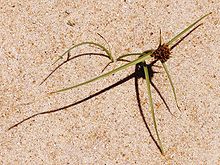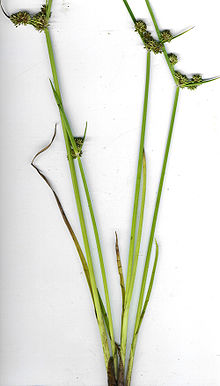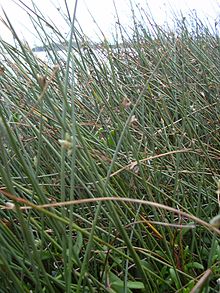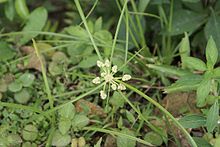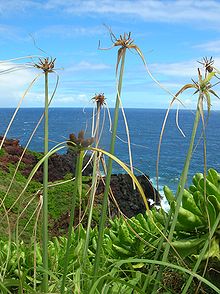- Cyperus
-
Cyperus 
Dwarf Umbrella-sedge, Cyperus albostriatus Scientific classification Kingdom: Plantae (unranked): Angiosperms (unranked): Monocots (unranked): Commelinids Order: Poales Family: Cyperaceae Genus: Cyperus
L.Species About 600, see text
Synonyms Pycreus
Cyperus is a large genus of about 600 species of sedges, distributed throughout all continents in both tropical and temperate regions. They are annual or perennial plants, mostly aquatic and growing in still or slow-moving water up to 0.5 m deep. The species vary greatly in size, with small species only 5 cm tall, while others can reach 5 m in height. Common names include papyrus sedges, flatsedges, nutsedges, umbrella-sedges and galingales.
The stems are circular in cross-section in some, triangular in others, usually leafless for most of their length, with the slender grass-like leaves at the base of the plant, and in a whorl at the apex of the flowering stems. The flowers are greenish, and wind pollinated; they are produced in clusters among the apical leaves. The seed is a small nutlet.
Contents
Ecology
Cyperus species are used as food plants by the larvae of some Lepidoptera species, including Batrachedra cuniculata. The seeds and tubers are an important food for many small birds and mammals.
Cyperus microcristatus and C. multifolius are possibly extinct; the former was only found once, in 1995, and the latter has not been seen in the last 200 years. The "true" papyrus sedge of Ancient Egypt, C. papyrus ssp. hadidii, is also very rare today due to draining of its wetland habitat; feared extinct in the mid-20th century, it is still found at a few sites in the Wadi El Natrun region and northern Sudan.
Some tuber-bearing species on the other hand, most significantly the Purple Nutsedge (C. rotundus), are considered invasive weeds.
Use by humans
Papyrus Sedge (C. papyrus) of Africa was of major historical importance in providing papyrus. C. giganteus, locally known as cañita, is used by the Yokot'an Maya of Tabasco, Mexico, for weaving petates (sleeping mats) and sombreros. C. textilis and C. pangorei are traditionally used to produce the typical mats of Palakkad in India, and the makaloa mats of Niihau were made from C. laevigatus.
The Chufa Flatsedge (C. esculentus) has edible tubers and is grown commercially for these; they are eaten as vegetables, made into sweets, or used to produce the horchata of the Valencia region. Several other species - e.g. Australian Bush Onion (C. bulbosus) - are eaten to a smaller extent. For some Northern Paiutes, Cyperus tubers were a mainstay food, to the extent that they were known as tövusi-dökadö ("nutsedge tuber eaters").[verification needed]
Most species are of little economic value. Some are grown as ornamental or pot plants, namely the Umbrella Papyrus (C. alternifolius ), the Dwarf Umbrella-sedge (C. albostriatus, formerly called C. diffusus), and related species. There is increasing interest in the larger, fast-growing species as crops for paper and biofuel production.
Some Cyperus are used in folk medicine. Roots of Near East species were a component of kyphi, a medical incense of Ancient Egypt. Purple Nutsedge (C. rotundus) tubers are used in Kampō. An unspecified Cyperus is mentioned as an abortifacient in the 11th-century poem De viribus herbarum[1].
Selected species
- Cyperus acuminatus
- Cyperus albostriatus (syn. C. diffusus) – Dwarf Umbrella-sedge
- Cyperus alopecuroides
- Cyperus alternifolius – Umbrella Papyrus, "umbrella palm", "umbrella plant"
- Cyperus alternifolius ssp. flabelliformis (syn. C. involucratus)
- Cyperus angustatus
- Cyperus aquatilis
- Cyperus arenarius
- Cyperus bipartitus – Shining Flat sedge, River Cyperus
- Cyperus bowmannii
- Cyperus breviculmis
- Cyperus bulbosus – Australian Bush Onion, "wild onion" (Australia)
- Cyperus capitatus
- Cyperus carinatus
- Cyperus cephalotes
- Cyperus compressus
- Cyperus concinnus
- Cyperus congestus – Dense Flatsedge
- Cyperus conglomeratus
- Cyperus conicus
- Cyperus crassipes[verification needed]
- Cyperus cyperoides
- Cyperus decompositus
- Cyperus dentatus – Toothed Umbrella-sedge
- Cyperus diandrus – Umbrella Flatsedge
- Cyperus difformis – Variable Flatsedge, Small-flowered Umbrella-sedge
- Cyperus distachyos
- Cyperus distans[2]
- Cyperus dives
- Cyperus duripes
- Cyperus echinatus – Globe Flatsedge
- Cyperus enervis
- Cyperus eragrostis – Tall Flatsedge, Pale Galingale
- Cyperus erythrorhizos – Redroot Flatsedge
- Cyperus esculentus – Chufa Flatsedge, Tigernut Sedge, Yellow Nutsedge, Yellow Nutgrass, Yellow Umbrella-sedge, Earthalmond
- Cyperus fauriei
- Cyperus fertilis
- Cyperus flaccidus
- Cyperus flavescens – Yellow Flatsedge, Yellow Galingale, Yellow Cyperus
- Cyperus fulvus
- Cyperus fuscus – Brown Flatsedge, Brown Galingale
- Cyperus gracilis – Slender Flat sedge
- Cyperus grayoides
- Cyperus giganteus – "piripiri", cañita
- Cyperus haspan (syn. C. halpan)
- Cyperus helferi
- Cyperus hillebrandii
- Cyperus hillebrandii ssp. decipiens
- Cyperus hillebrandii ssp. hillebrandii
- Cyperus holoschoenus
- Cyperus houghtonii – Houghton's Umbrella-sedge, Houghton's Flatsedge, Houghton's Cyperus
- Cyperus imbecillis
- Cyperus ixiocarpus
- Cyperus javanicus
- Cyperus laevigatus – makaloa (Niihau)
- Cyperus laevis
- Cyperus longus – Common Galingale
- Cyperus longus var. badius
- Cyperus lucidus
- Cyperus lupulinus – Great Plains Flatsedge
- Cyperus lupulinus ssp. macilentus
- Cyperus luzulae
- Cyperus malaccensis – Malacca Galingale
- Cyperus michelianus[verification needed]
- Cyperus microcephalus
- Cyperus microcristatus
- Cyperus multifolius
- Cyperus niger
- Cyperus odoratus – Rusty Flatsedge
- Cyperus ornatus
- Cyperus pangorei
- Cyperus papyrus – Papyrus Sedge
- Cyperus papyrus ssp. hadidii – Egyptian Papyrus Sedge
- Cyperus papyrus cv. 'Perkamentos'
- Cyperus parishii
- Cyperus pedunculatus
- Cyperus pedunculosus
- Cyperus pennatiformis
- Cyperus pennatiformis ssp. bryanii – Laysan Sedge
- Cyperus phleoides
- Cyperus platystylis
- Cyperus polystachyos
- Cyperus prolifer – Dwarf Papyrus
- Cyperus pulchellus
- Cyperus rheophytorum
- Cyperus rotundus – Purple Nutsedge, Red Nutsedge, Coco Grass, butones butones (Philippines)
- Cyperus scaber
- Cyperus scariosus
- Cyperus schweinitzii – Schweinitz' Flatsedge, Schweinitz' Umbrella-sedge
- Cyperus serotinus
- Cyperus sexflorus
- Cyperus sphaerolepis
- Cyperus sporobolus
- Cyperus squarrosus – Awned Cyperus
- Cyperus strigosus – Straw-coloured Flatsedge, Straw-colored Cyperus
- Cyperus subulatus
- Cyperus tegetiformis (syn. C. malaccensis var. brevifolius) – Shichitoi, Short-leaved Malacca Galingale
- Cyperus tetraphyllus
- Cyperus textilis
- Cyperus trachysanthos - pu`uka`a
- Cyperus trinervis
- Cyperus umbilensis
- Cyperus unioloides
- Cyperus ustulatus
- Cyperus vaginatus
- Cyperus ventricosus
- Cyperus virens
See also
- Amphoe Nong Prue, a district in Thailand. The name of its capital Nong Prue (หนองปรือ) literally means "Cyperus swamp".
- The Cyperus-like Sedge (Carex pseudocyperus) is a related plant convergent in appearance to Cyperus. It is often called "Cyperus Sedge" in regions where no true Cyperus occurs.
Footnotes
- ^ Riddle (1992)
- ^ Bussmann, R. W., et al. (2006). Plant use of the Maasai of Sekenani Valley, Maasai Mara, Kenya. J Ethnobiol Ethnomed 2 22.
References
- Riddle, John M. (1992): Contraception and Abortion from the Ancient World to the Renaissance. Harvard University Press, Cambridge, MA.
External links
Categories:- Cyperus
- Cyperaceae genera
Wikimedia Foundation. 2010.
Cyperus — Cyperus … Wikipédia en Français
Cyperus — Cyp e*rus (s?p ? r?s), n. [NL., from Gr. ???? sedge.] (Bot.) A large genus of plants belonging to the Sedge family, and including the species called galingale, several bulrushes, and the Egyptian papyrus. [1913 Webster] … The Collaborative International Dictionary of English
Cypĕrus — L. (Cypergras), Gattung der Cyperazeen, ein oder mehrjährige, niedrige oder ansehnliche Riedgräser mit beblätterten, selten blattlosen, blütentragenden Halmen, meist flachen Blättern, in kopfförmigen Büscheln oder Trugdolden stehenden… … Meyers Großes Konversations-Lexikon
Cyperus — Cypĕrus L., Cypergras, Pflanzengattg. der Cyperazeen C. esculentus L., Mittelmeerländer, vielfach kultiviert; die nußartig schmeckenden Knollen (Erdmandeln) liefern wohlschmeckendes Öl, sind auch Kaffeesurrogat. C. papȳrus L., die Papierstaude,… … Kleines Konversations-Lexikon
Cyperus — diffusu … Wikipédia en Français
Cyperus — Cyperus Cyperus albostriatus … Wikipedia Español
Cyperus — Zypergräser Braunes Zypergras (Cyperus fuscus) Systematik Unterklasse: Commelinaähnliche (Commelinidae) … Deutsch Wikipedia
Cyperus — noun type genus of Cyperaceae; grasslike rhizomatous herbs; cosmopolitan except very cold regions • Syn: ↑genus Cyperus • Hypernyms: ↑monocot genus, ↑liliopsid genus, ↑Cyperaceae, ↑family Cyperaceae, ↑sedge family … Useful english dictionary
Cyperus — viksvuolė statusas T sritis vardynas apibrėžtis Viksvuolinių (Cyperaceae) šeimos augalų gentis (Cyperus). atitikmenys: lot. Cyperus angl. cyperus; cypress grass; flatsedge; galingale vok. Zypergras rus. сныть; циперус lenk. cibora; cyperus … Dekoratyvinių augalų vardynas
cyperus — viksvuolė statusas T sritis vardynas apibrėžtis Viksvuolinių (Cyperaceae) šeimos augalų gentis (Cyperus). atitikmenys: lot. Cyperus angl. cyperus; cypress grass; flatsedge; galingale vok. Zypergras rus. сныть; циперус lenk. cibora; cyperus … Dekoratyvinių augalų vardynas


